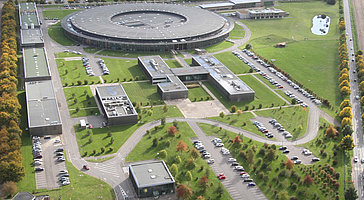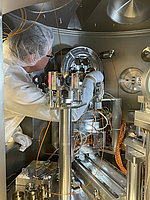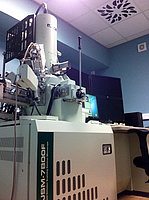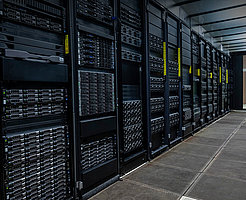(PMM) Physique des Matériaux et Molécules
Physics of Materials and Molecules est un parcours de deux ans du Master de Physique Fondamentale et Applications avec possibilité d'entrée en première et deuxième année. Il est destiné à des étudiants formés en physique fondamentale ou physique-chimie. Le master a vocation à former les étudiants dans un contexte scientifique international, il est donc enseigné en anglais et ouvert à des étudiants de tous horizons.
Objectifs de la formation
Le parcours Physics of Materials and Molecules du Master Physique Fondamentale et Applications a pour objectif de former des physiciens en capacité d'affronter les grandes questions scientifiques du XXIᵉ siècle, de problématiques concrètes et appliquées telles que la conception de nouveaux matériaux pour l'industrie de demain, plus compatibles avec les enjeux environnementaux et énergétiques de notre époque ; à des questions fondamentales comme le comportement de la matière au sein des planètes et atmosphères, des méthodes de calcul à l'échelle atomique ou l'utilisation des grands instruments de recherche internationale.
La formation se repose sur les compétences issues de laboratoires du département de physique : UMET (Unité Matériaux et Transformations), PhLAM (Laboratoire de Physique des Lasers, Atomes et Molécules), IEMN (Institut d'Electronique, de Microélectronique et de Nanotechnologie) et LOA (Laboratoire d'Optique Atmosphérique).
Profils de recrutement
Les étudiants recherchés pour une entrée en première année seront issus d'une licence de Physique Fondamentale, d'une licence de Physique - Chimie, ou équivalent. Nous acceptons, aussi, des inscriptions directes en deuxième année pour des étudiants pouvant justifier d'une première année de master ou d'une quatrième année de formation d'étude supérieures.
Les procédures d'inscriptions dépendent de votre origine et sont décrites dans les pages dédiées aux inscriptions en première année et aux inscriptions en deuxième année.
Science de solutions - Science de découvertes

La formation s'adresse à deux profils d'étudiants :
- des étudiants en recherche de solutions, qui seront formés aux dernières avancées en sciences de la matière, qui pourront ainsi développer et exploiter de nouveaux matériaux, les dernières méthodes d'analyses, et les outils analytiques pour affronter les problématiques sociétales aujourd'hui (transition énergétique, sobriété, recyclage, etc) sous l'angle de la physique des matériaux ;
- des étudiants en recherche de découvertes, qui pourront se reposer sur leur formation pour comprendre le devenir de la matière dans de divers environnements et conditions, du cœur d'une centrale nucléaire, aux polymères, métaux, matériaux pharmaceutiques, et jusqu'à l'intérieur des planètes ou l'atmosphère.
Méthodes et outils analytiques
Dans leur cursus, les étudiants auront l'opportunité de se former
- à l'usage de méthodes de caractérisation avancées de spectroscopies et diffractions, sur des instruments de haut niveau tels que les microscopes électroniques à balayage et en transmission de la Plateforme de Microscopie Electronique de Lille ;
- à analyser les données issues d'expériences sur de grands instruments de recherche ou des accélérateurs (le synchrotron SOLEIL par exemple) ;
- sans oublier le parc d'instruments des laboratoires partenaires.
Ils seront aussi amenés à se former à des méthodes numériques de modélisation de la matière, telles que
- la dynamique moléculaire ;
- les calculs par la méthode de Hartree-Fock ;
- ou en encore de la théorie de la fonctionnelle de la densité (DFT).
International
Le parcours fait partie du Graduate Program Materiaux pour un futur durable / Materials for a Sustainable Futur de l'Université de Lille qui vise à former des scientifiques prêts à relever les principaux défis liés aux transitions en cours à travers la science des matériaux. Il est aussi associé au programme Erasmus Mundus BIOPHAM qui offre une formation en science des matériaux dédiés à des applications pharmaceutiques et avec lequel il partage environ 50 % de ses enseignements.
Afin d'accueillir des étudiants de tous horizons et préparer les étudiants à travailler dans un contexte européen et international, la langue d'enseignement est l'anglais. Les enseignants sont francophones et en mesure de répondre aux questions et interagir en français, mais les cours sont donnés en anglais.
Les compétences acquises à l’issue du master
Les étudiants du parcours Physics of Materials and Molecules deviendront des experts d'une approche physique de la science des matériaux et des molécules, avec des enseignements de thermodynamique avancée, de physique des solides, de leurs propriétés mécaniques, et de physique atomique et moléculaire. Les applications visées concernent divers domaines telles que les matériaux métalliques, céramiques, polymères, architecturés, à l'échelle nanométrique, ou encore des molécules à l'état dilué dans l'atmosphère ou l'espace interstellaire.
Ils seront formés à des méthodes de caractérisation avancées telles que la diffraction des rayons X, la microscopie électronique ou les spectroscopies. Ils seront aussi formés aux possibilités ouvertes pour l'étude des propriétés de la matière et des molécules par les méthodes de télédétection par satellite ou autres outils, ou encore l'utilisation de grands instruments et accélérateurs tels que les synchrotrons ou lasers à électrons libres.
La formation inclut aussi des aspects de sciences du numérique. La première année propose des enseignements généralistes tels que la présentation de l'intelligence artificielle et de l'apprentissage automatique et leurs usages pour la physique. Sur les deux années, les étudiants sont aussi formés aux méthodes numériques spécifiques aux sciences des matériaux et molécules telles que les calculs de dynamique moléculaire ou ceux basés sur la théorie de la fonctionnelle de la densité (DFT, sigle pour Density Functional Theory).
Enfin, les étudiants auront l'occasion de travailler leurs compétences générales, de communication, et de travail dans un contexte professionnel, avec des enseignements de langue, des enseignements spécialisés en mode projet incluant des présentations orales et par poster, et des stages de longue durée.
Ils seront ainsi préparés à des études doctorales ainsi qu'à des carrières en recherche et développement dans l'industrie ou dans le secteur public.
Programme
Le master est organisé en 2 années et 4 semestres de 30 crédits chacun avec des enseignements et stages de septembre à juin ou juillet, pour un total de 120 crédits ECTS. Afin d'accueillir des étudiants de tous horizons et préparer les étudiants à travailler dans un contexte européen et international, la langue d'enseignement est l'anglais. Les enseignants sont en grande majorité francophones et en mesure de répondre aux questions et interagir en français, mais les cours sont donnés en anglais.
Les enseignements sont structurés en 3 blocs de compétences et connaissances (BCC) décrits ci-dessous.
Les blocs de connaissances et de compétences (BCC)
Année 1 – Semestre S1
- AI and advanced computational methods in physics – 3 ECTS
Explore the intersection of AI, Machine Learning, and Physics in this class. Gain hands-on experience with cutting-edge techniques and applications tailored for the world of physics. - Atomic scale modeling I – 3 ECTS
Discover powerful simulation techniques like Molecular Dynamics and Monte Carlo to predict and design material properties at the atomic scale. - States of Matter and Materials Science Primers – 3 ECTS
Have a clear understanding of the different families of materials (metals and alloys, ceramics, polymers) based on their properties and microstructure.
Année 1 – Semestre S2
- Satellites and remote sensing – 3 ECTS
Master the principles and applications of remote sensing and satellite technology through comprehensive lectures and practical work with insights into environmental monitoring and cutting edge research. - Radiative transfer and radiation-matter interactions – 3 ECTS
Master the principles and applications of radiation-matter interaction in the context of atmospheric studies. Through a good balance between theoretical, numerical and practical elements. - Large scale research infrastructures – 3 ECTS
This course aims to introduce students to the principles, functioning, and applications of major large scale research infrastructures (LSRI) used in both fundamental and applied research.
Année 2 – Semestre S3
- Structural properties of matter : electron microscopy and diffraction – 3 ECTS
Characterize the state of materials at the crystal to nanometer scale using advanced experimental methods such as the scanning and transmission electron microscope, and powder X-ray diffraction - Atomic scale modeling II – 3 ECTS
Discover quantum first principles methods to solve the problem of the electronic structure of molecular systems, from isolated molecules to solids - Advanced Spectroscopy of Molecular Systems: From Gas Phase to Condensed Matter (ASMS) – 3 ECTS
This course aims to introduce fundamental principles in molecular physics characterization by optical (vibrational, rotational) and neutron spectroscopies, as well as dielectric techniques.
Année 1 – Semestre S1
- Foreign language (French or English) – 3 ECTS
Improve your communication skills in a foreign language - PE or Graduate Program Special Teaching – 3 ECTS
Learn on current topic from the Materials for a Sustainable Future graduate program - Tutored trainings – 3 ECTS
Discover new topics in physics based on the scientific literature, and develop your teaching and presentation skills in front of your peers.
Année 1 – Semestre S2
- Tutored trainings – 3 ECTS
Discover new topics in physics based on the scientific literature, and develop your teaching and presentation skills in front of your peers. - Experimental project – 3 ECTS
Develop students’ autonomy, scientific rigor, and technical skills through the realization of an experimental project in pairs. Apply theoretical knowledge acquired so far to solve a real-world problem. - Internship – 6 ECTS
A two-month-long experience in a professional working environment
Année 2 – Semestre S3
- Foreign language (French or English) – 3 ECTS
Improve your communication skills in a foreign language - Speciality (pick 3 out of 5 – 2 ECTS each):
- Materials under extreme conditions: fundamentals in state of matter under extreme pressure and temperatures with applications in condensed matter, materials, and planetary sciences.
- Metals and alloys: discover elements of research in physical metallurgy, from fundamental research to real world applications.
- Polymers: Gain insights into the structure-property relationships of polymer materials and understand essential characterization and processing techniques. Learn to select the polymer in relation to use properties.
- Mathematical crystallography: mathematical formalism to discover relationships between planes and directions, symmetry operations, coordinate transformations, and conversions from direct to reciprocal space.
- Instrumentation in spectroscopy: fundamentals of spectroscopy, instrumentations, and relations to the domain of relevance (environmental sciences, astrophysics, energy, human health, drug design, fundamental physics, etc.).
Année 2 – Semestre S4
- PE or Graduate Program Special Teaching – 3 ECTS
Learn on current topic from the Materials for a Sustainable Future graduate program - Internship – 27 ECTS
A five-month-long experience in a professional working environment
Année 1 – Semestre S1
- Continuum mechanics – 3 ECTS
Introduction to the principles of stress, strain, anisotropic and isotropic elasticity with applications covering a broad area relating to the mechanical behavior of materials. - Statistical physics and critical phenomena – 3 ECTS
Fundamental concepts in statistical physics, focusing on Bose-Einstein and Fermi-Dirac statistics, phase transitions, critical phenomena, and the renormalization group. - Condensed matter I – Electrons – 3 ECTS
Basics on electronic properties in solid state physics, covering equilibrium and transport properties of crystalline solids, from the Sommerfeld model to semi-conductors. - Atomic physics – 3 ECTS
Explore the quantum mechanical description of both single and multi-electron atoms, gain a deeper understanding of the periodic table's structure, and investigate how atoms interact with light and how their spectra provide insights into these systems.
Année 1 – Semestre S2
- Condensed Matter II – Phonons – 3 ECTS
This lecture explores the vibrational properties of crystalline solids, from lattice symmetries and phonon dispersion to thermodynamic behavior. It provides the fundamental tools to understand heat capacity, thermal transport, and the quantum nature of lattice vibrations in condensed matter systems. - Fundamentals of molecular spectroscopy – 3 ECTS
Gain a solid understanding of the quantum mechanical principles behind molecular spectroscopy, with emphasis on rotational and vibrational transitions and the role of symmetry in determining spectroscopic activity. - Microstructures and defects in materials – 3 ECTS
Discover how grains, defects, and other microstructural elements and how they control the physical properties of materials.
Année 2 – Semestre S3
- Advanced thermodynamics and phase transformations – 3 ECTS
This course explores the principles governing crystalline and amorphous physical states and their transformations across diverse materials like metallic alloys, glasses, and polymers. - Molecular mobility and amorphous state of matter – 3 ECTS
This course presents the characteristics of molecular motions found in amorphous materials in the supercooled and glassy states, and the temperature dependence of these dynamics. - From macro to nanophysics – 3 ECTS
Introduce the physics of nanomaterials, and show how optical / electromagnetic / thermal / mechanical properties are modified from macroscopic to the nanometer scale. - Materials plasticity – 3 ECTS
Physical basis of plasticity of crystalline solids, from the elementary mechanisms to the plastic behavior in various conditions.
Syllabus
Vous trouverez le détail des contenus des enseignements dans le syllabus détaillé suivant.
Enseignements de première année
La première année est divisée en deux semestres, avec des enseignements
- de septembre à décembre pour le premier semestre ;
- de janvier à fin avril pour le second semestre ;
- un stage de deux mois en mai et juin (pouvant être prolongé en juillet et août).
Le programme repose sur des enseignements traditionnels sous forme de cours et de travaux dirigés, des enseignements par projet, et de travaux pratiques, à la fois numériques et instrumentaux.
Les enseignements sont en partie mutualisés avec les parcours Quantum and Photonic Technologies (QPT), Advanced Physics of Pharmaceutical Materials (A2PM), et le parcours Erasmus Mundus BIOPHAM.
Le détail des enseignements de chaque semestre et leur répartition en blocs de compétences et connaissances et unités d'enseignements sont décrits ci-dessous.
Liste des cours (année 1)
BCC1 : Mettre en œuvre des outils et des démarches de physique fondamentale pour produire des savoirs hautement spécialisés – 9 ECTS
- AI and advanced computational methods in physics – 3 ECTS
Explore the intersection of AI, Machine Learning, and Physics in this class. Gain hands-on experience with cutting-edge techniques and applications tailored for the world of physics. - Atomic scale modeling I – 3 ECTS
Discover powerful simulation techniques like Molecular Dynamics and Monte Carlo to predict and design material properties at the atomic scale. - States of Matter and Materials Science Primers – 3 ECTS
Have a clear understanding of the different families of materials (metals and alloys, ceramics, polymers) based on their properties and microstructure.
BCC2 : Produire et communiquer des savoirs hautement spécialisés, y compris dans un contexte professionnel – 9 ECTS
- Foreign language (French or English) – 3 ECTS
Improve your communication skills in a foreign language - PE or Graduate Program Special Teaching – 3 ECTS
Learn on current topic from the Materials for a Sustainable Future graduate program - Tutored trainings – 3 ECTS
Discover new topics in physics based on the scientific literature, and develop your teaching and presentation skills in front of your peers.
BCC3 : Résoudre des problèmes complexes en mobilisant les concepts de la physique fondamentale – 12 ECTS
- Continuum mechanics – 3 ECTS
Introduction to the principles of stress, strain, anisotropic and isotropic elasticity with applications covering a broad area relating to the mechanical behavior of materials. - Statistical physics and critical phenomena – 3 ECTS
Fundamental concepts in statistical physics, focusing on Bose-Einstein and Fermi-Dirac statistics, phase transitions, critical phenomena, and the renormalization group. - Condensed matter I – Electrons – 3 ECTS
Basics on electronic properties in solid state physics, covering equilibrium and transport properties of crystalline solids, from the Sommerfeld model to semi-conductors. - Atomic physics – 3 ECTS
Explore the quantum mechanical description of both single and multi-electron atoms, gain a deeper understanding of the periodic table's structure, and investigate how atoms interact with light and how their spectra provide insights into these systems.
BCC1 : Mettre en œuvre des outils et des démarches de physique fondamentale pour produire des savoirs hautement spécialisés – 9 ECTS
- Satellites and remote sensing – 3 ECTS
Master the principles and applications of remote sensing and satellite technology through comprehensive lectures and practical work with insights into environmental monitoring and cutting edge research. - Radiative transfer and radiation-matter interactions – 3 ECTS
Master the principles and applications of radiation-matter interaction in the context of atmospheric studies. Through a good balance between theoretical, numerical and practical elements. - Large scale research infrastructures – 3 ECTS
This course aims to introduce students to the principles, functioning, and applications of major large scale research infrastructures (LSRI) used in both fundamental and applied research.
BCC2 : Produire et communiquer des savoirs hautement spécialisés, y compris dans un contexte professionnel – 12 ECTS
- Tutored trainings – 3 ECTS
Discover new topics in physics based on the scientific literature, and develop your teaching and presentation skills in front of your peers. - Experimental project – 3 ECTS
Develop students’ autonomy, scientific rigor, and technical skills through the realization of an experimental project in pairs. Apply theoretical knowledge acquired so far to solve a real-world problem. - Internship – 6 ECTS
A two-month-long experience in a professional working environment
BCC3 : Résoudre des problèmes complexes en mobilisant les concepts de la physique fondamentale – 9 ECTS
- Condensed Matter II – Phonons – 3 ECTS
This lecture explores the vibrational properties of crystalline solids, from lattice symmetries and phonon dispersion to thermodynamic behavior. It provides the fundamental tools to understand heat capacity, thermal transport, and the quantum nature of lattice vibrations in condensed matter systems. - Fundamentals of molecular spectroscopy – 3 ECTS
Gain a solid understanding of the quantum mechanical principles behind molecular spectroscopy, with emphasis on rotational and vibrational transitions and the role of symmetry in determining spectroscopic activity. - Microstructures and defects in materials – 3 ECTS
Discover how grains, defects, and other microstructural elements and how they control the physical properties of materials.
Syllabus
Vous trouverez le détail des contenus des enseignements dans le syllabus détaillé suivant.
Enseignements de deuxième année
La deuxième année est divisée en deux semestres, avec
- des enseignements de septembre à janvier ;
- un stage de cinq mois débutant fin janvier et finissant fin juin (qui peut être prolongé en juillet et août, mais doit durer moins de 6 mois).
Comme en première année, le programme repose sur des enseignements traditionnels sous forme de cours et de travaux dirigés, des enseignements par projet, et travaux pratiques, à la fois numériques et instrumentaux. Les étudiants ont aussi l'occasion de travailler directement sur des appareils de recherche, comme des spectromètres et des microscopes électroniques.
Certains enseignements sont mutualisés avec les parcours Advanced Physics of Pharmaceutical Materials (A2PM), et le parcours Erasmus Mundus BIOPHAM.
Le détail des enseignements de chaque semestre et leur répartition en blocs de compétences et connaissances et unités d'enseignements sont décrits ci-dessous.
Liste des cours (année 2)
BCC1 : Mettre en œuvre des outils et des démarches de physique fondamentale pour produire des savoirs hautement spécialisés – 9 ECTS
- Structural properties of matter : electron microscopy and diffraction – 3 ECTS
Characterize the state of materials at the crystal to nanometer scale using advanced experimental methods such as the scanning and transmission electron microscope, and powder X-ray diffraction - Atomic scale modeling II – 3 ECTS
Discover quantum first principles methods to solve the problem of the electronic structure of molecular systems, from isolated molecules to solids - Advanced Spectroscopy of Molecular Systems: From Gas Phase to Condensed Matter (ASMS) – 3 ECTS
This course aims to introduce fundamental principles in molecular physics characterization by optical (vibrational, rotational) and neutron spectroscopies, as well as dielectric techniques.
BCC2 : Produire et communiquer des savoirs hautement spécialisés, y compris dans un contexte professionnel – 9 ECTS
- Foreign language (French or English) – 3 ECTS
Improve your communication skills in a foreign language - Speciality (pick 3 out of 5 – 2 ECTS each):
- Materials under extreme conditions: fundamentals in state of matter under extreme pressure and temperatures with applications in condensed matter, materials, and planetary sciences.
- Metals and alloys: discover elements of research in physical metallurgy, from fundamental research to real world applications.
- Polymers: Gain insights into the structure-property relationships of polymer materials and understand essential characterization and processing techniques. Learn to select the polymer in relation to use properties.
- Mathematical crystallography: mathematical formalism to discover relationships between planes and directions, symmetry operations, coordinate transformations, and conversions from direct to reciprocal space.
- Instrumentation in spectroscopy: fundamentals of spectroscopy, instrumentations, and relations to the domain of relevance (environmental sciences, astrophysics, energy, human health, drug design, fundamental physics, etc.).
BCC3 : Résoudre des problèmes complexes en mobilisant les concepts de la physique fondamentale – 12 ECTS
- Advanced thermodynamics and phase transformations – 3 ECTS
This course explores the principles governing crystalline and amorphous physical states and their transformations across diverse materials like metallic alloys, glasses, and polymers. - Molecular mobility and amorphous state of matter – 3 ECTS
This course presents the characteristics of molecular motions found in amorphous materials in the supercooled and glassy states, and the temperature dependence of these dynamics. - From macro to nanophysics – 3 ECTS
Introduce the physics of nanomaterials, and show how optical / electromagnetic / thermal / mechanical properties are modified from macroscopic to the nanometer scale. - Materials plasticity – 3 ECTS
Physical basis of plasticity of crystalline solids, from the elementary mechanisms to the plastic behavior in various conditions.
BCC2 : Produire et communiquer des savoirs hautement spécialisés, y compris dans un contexte professionnel – 12 ECTS
- PE or Graduate Program Special Teaching – 3 ECTS
Learn on current topic from the Materials for a Sustainable Future graduate program - Internship – 27 ECTS
A five-month-long experience in a professional working environment
Syllabus
Vous trouverez le détail des contenus des enseignements dans le syllabus détaillé suivant.
Métiers & Débouchés
Le parcours Physics of Materials and Molecules permet le Recrutement dans des laboratoires de recherche publics ou privés (de grands groupes, PME, ETI, start-up, EPIC) dans l'un des nombreux domaines couverts par le parcours. Il est possible d'entrer dans la vie active directement après l'obtention du diplôme ou après des études complémentaires et un doctorat.
Les données ci-dessous sont issues de statistiques réalisées sur environ 60 étudiants formés dans ce parcours ou ses prédécesseurs. Il permettent de se faire une idée précise et documentée du devenir des étudiants issus de la formation.
Thèses
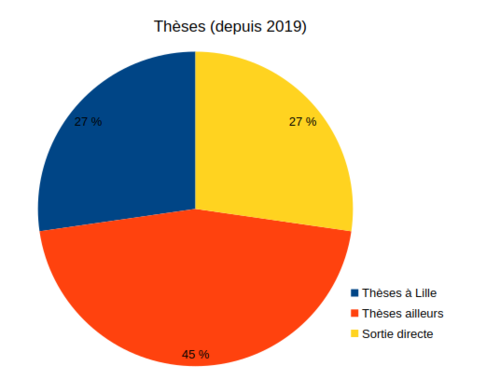
A l'issu du master, environ 75% des étudiants passés par le master depuis 2019 continuent sur une thèse de doctorat, à Lille ou ailleurs. Les autres continuent vers un emploi direct.
Emplois et secteurs d'activité
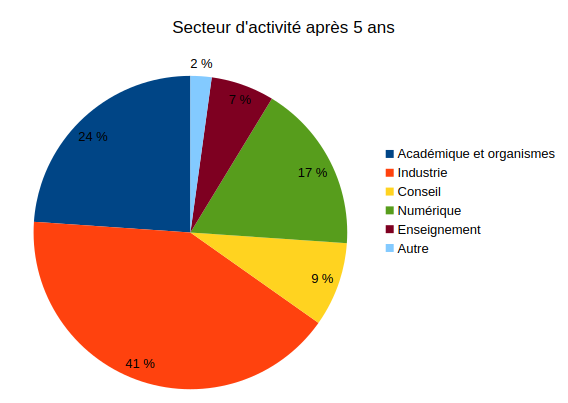
En s'intéressant aux étudiants 5 ans ou plus après leur master (afin d'avoir des statistiques non affectées par les doctorats en cours), voici les secteurs d'activé et employeurs identifiés (sur une base de 60 étudiants) :
- académique ou de grands organismes d'état (24%) dont les employeurs sont le CNRS, les universités de Yale et de Phœnix (États-Unis), les universités de Tours et de Lille ou Grenoble INP en France, l'Universitas 17 Agustus 1945 Surabaya en Indonésie, les Canadian Nuclear Laboratories, le CEA, l'Onera, ou l'Université Libre de Bruxelles ;
- industrie (41 %) : Siemens Energy, Framatome, EDF, Décathlon, Altsom, Raclot Industries, AstraZeneca, Imerys, Groupe Institut de Soudure, ITP Interpipe, Blue Capsule Technology, PPG ;
- conseil (9 %) et numérique (17 %) : Devoteam G Cloud, Sopra HR Software, Sopra Banking Software, Groupe Luminess, Axecom, Calogena, DEF, Assystem, Power Inside Data ;
- enseignement dans le secondaire : 7 % ;
- reconversion : 2 %.
Suite à leur thèse de doctorat, un certain nombre d'étudiants travaillent donc dans des activités de R&D dans de grands organismes publics (CEA, Onera, universités, etc) mais aussi privés (EDF, Framatome, Siemens, etc) quand d'autres se dirigent vers des branches de conseil ou de l'industrie numérique.
Fonctions occupées
Quelques exemples des fonctions occupées par des anciens étudiants :
- R&D Manager, Racot Industries
- Fire Satety and EcoDesign Engineer, Alstom
- Ingérnieur produits, Décathlon
- Maître de conférences, Université de Tours
- Enseignant, Education Nationale
- Clinical Trial Associate, Aquilab
- Computational research scientist, Canadian Nuclear Laboratories
- Data scientist, Siemens,
- Senior research scientist, Univ. Yale
- Cloud infrastructure architect, Devoteam
- Chargé de recherches, CNRS
- Head of physics laboratory, Indonesia
- Ingénieur d'études, Grenoble INP
- Ingénieur innovation, ITP Interpipe
- Senior scientist, Astra Zenecca
- Ingénieur systèmes, Alstom
- Consulting Engineer, Prodigyus
- Ingénieur accidents grave, Framatome
- Ingénieur, EDF
- Responsable produits, Groupe Institut Soudures
- Research Engineer, Onera
- Physics faculty, Phoenix University
- Ingénieur matériaux et modélisations, Blue capsule technology
- Ingénieur de recherches, CNRS
- Technical lead, Nuclear AMRC
- Industrial Project Manager, Imerys
Exemples de travaux de recherche
Vous trouverez, ci-dessous, des exemples de travaux publiés dans la littérature scientifique par des anciens étudiants du master. Les sujets abordés vont de la stabilité de médicaments aux météorites tout en passant pas le comportement de métaux irradiés dans un réacteur nucléaire, la synthèse de nouveaux polymères à base d'amidon, des développements de méthodes expérimentales avancées, des matériaux pour stocker le gaz et résoudre des problématiques énergétiques, ou encore les propriétés mécaniques des matériaux du manteau terrestre.
Prussian Blue Analog nanocrystals are nano-objects at the frontier between molecules and bulk materials and have molecular properties that can be used for different applications such as gas storage materials for energy issues, magnetic properties for information storage, electrochemical and biosensors, catalysis, environmental purification, or biomedical applications. This work is a study of the electron transport properties at the nanoscale of individual Prussian Blue Analog cubic nanocrystals. The conductivity values measured on individual nanocrystals are up to fifty times higher than those reported on PBA films.
Full publication : H. Therssen, L. Catala, S. Mazérat, T. Mallah, D. Vuillaume, T. Mélin & S. Lenfant. Electronic properties of single Prussian Blue Analog nanocrystals determined by conductive-AFM (2023) Nanoscale 15 19128-19138 [doi: 10.1039/d3nr04542k]
Drug solubility and bioavailability are the most important formulation challenges in pharmaceutical development, probably because a major part of the active pharmaceutical ingredients (APIs) are synthesized in the crystalline state which is often a poorly water-soluble state. Mesoporous silica carriers have recently gained interest in the pharmaceutical domain because of their potential to significantly increase the solubility of poorly water-soluble drugs, by adsorbing the active molecule in an amorphous and relatively stable state. This work shows that co-milling of porous SBA-15 matrix with the drug makes it possible the drug loading without significant damage for the structure of the matrix, enhancing thereby the capacity of loading to almost 40 wt%. It is shown that the physical state of ibuprofen (IBP) confined to silica carriers was amorphous between temperatures Tg and Tm of the bulk form of IBP.
Full publication : B. Malfait, N. Correia, A. Mussi, L. Paccou, Y. Guinet & A. Hédoux. Solid-state loading of organic molecular materials within mesoporous silica matrix: Application to ibuprofen (2019) Microporous and Mesoporous Materials 277 203-207 [doi: 10.1016/j.micromeso.2018.10.022]
Silicate glasses usually refer to amorphous materials in which SiO2 forms a network of corner-sharing tetrahedra. These vitreous phases can further incorporate different cations leading to the well-known categories of borosilicate glasses, aluminosilicate glasses or soda-lime glasses. This paper reports an initial investigation of the rheology of Mg2SiO4 glass through classical molecular dynamics simulations. The goal of the present study is therefore to analyse the mechanical response and rheological behaviour of an olivine glass of forsterite composition Mg2SiO4 and to elucidate how local atomic rearrangements evolve in the deformation process at low temperature.
Full publication : V. Delbecq, P. Carrez & P. Cordier. Rheological properties of Mg2SiO4 glass: A molecular dynamics study (2023) Journal of Non-Crystalline Solids 619 122572 [doi: 10.1016/j.jnoncrysol.2023.122572]
The plastic deformation of materials comes from the ability of crystal lattices to shear through the movements of dislocations. The interactions of the different mechanisms of deformation are complex and depend on each other. Their understanding is necessary, and a precise observation of these phenomena must be performed in order to take them into account when building theoretical models at the microstructural scale. This study is dedicated to the determination of the best methodology to apply for the characterization of dislocation densities that can be used as input in micro-mechanical modellings.
Full publication : J. Gallet, M. Perez, R. Guillou, C. Ernould, C. Le Bourlot, C. Langlois, B. Beausir, E. Bouzy, T. Chaise & S. Cazottes. Experimental measurement of dislocation density in metallic materials: A quantitative comparison between measurements techniques (XRD, R-ECCI, HR-EBSD, TEM) (2023) Materials Characterization 199 112842 [doi: 10.1016/j.matchar.2023.112842]
Materials systems subjected to external forcing are often observed to self-organize into patterns. Instabilities arise in these systems that can trigger the formation of transient structures, which then evolve into metastable or even stable steady-state patterns. Such patterns have been reported in solids and alloys subjected to irradiation and to severe plastic deformation, resulting in microstructures with emergent pattern length scales and symmetry. Using a simple model for point defect and chemical transport in an irradiated alloy, along with phase field simulations, this work reports on a novel compositional patterning phenomenon at grain boundaries and show that it results from solute advection to grain boundaries coupled with anisotropic solute diffusion at grain boundaries.
Full publication : G. F. Bouobda Moladje, R. S. Averback, P. Bellon & L. Thuinet. Convection-Induced Compositional Patterning at Grain Boundaries in Irradiated Alloys (2023) Physical Review Letters 131 056201 [doi: 10.1103/physrevlett.131.056201]
Sensing with terahertz (THz) radiations (100 GHz−10 THz, λ: 3 mm−30 μm) has demonstrated valuable purposes, e.g., for the uncovering of hidden items or the detection of relevant chemical and biochemical compounds. These works investigated the near-field distribution associated to the photonic mode of terahertz photonic micro-resonators by scattering scanning near-field optical microscopy and propose a scenario based on the combination of the near-field with the far-field pattern of the probe/resonator ensemble that is in excellent agreement with the experimental data and propose an image analysis procedure to recover the near-field of such structures.
Full publication : L. Thomas, T. Hannotte, C. N. Santos, B. Walter, M. Lavancier, S. Eliet, M. Faucher, J.-F. Lampin & R. Peretti. Imaging of THz Photonic Modes by Scattering Scanning Near-Field Optical Microscopy (2022) ACS Applied Materials & Interfaces 14 32608-32617 [doi: 10.1021/acsami.2c01871]
The ability of complex parts production directly from a computer aided design without machining or assembling step has increased the interests in Additive Manufacturing. Laser powder bed fusion, largely employed for additive manufacturing, induces after each batch a large quantity of remaining powder. This study focuses on the possibility to reuse this remaining powder after a large number of production cycles and on the influence of such reusing on the microstructure and mechanical properties.
Full publication : E. Paccou, M. Mokhtari, C. Keller, J. Nguejio, W. Lefebvre, X. Sauvage, S. Boileau, P. Babillot, P. Bernard & E. Bauster. Investigations of powder reusing on microstructure and mechanical properties of Inconel 718 obtained by additive manufacturing (2021) Materials Science and Engineering: A 828 142113 [doi: 10.1016/j.msea.2021.142113]
Considering the exhaustion of petroleum resources and consumer request for sustainable products, starch is one of the most inexpensive and readily available bio-based polymer that has attracted a great deal of interest as potential alternative to conventional plastics for packaging applications. Here, the structure-property relationships of almost fully substituted fatty acid starch esters are investigated as a function of both fatty acid chain length and amylose/amylopectin ratio of the starch. The structural study has revealed a layered type organization in which starch chain planes are separated by fatty chains. The latter are interpenetrated and/or tilted for FASE-C16 whatever the origin of the starch is, and fatty chains partially crystallizes into a structure with hexagonal symmetry.
Full publication : A. Vanmarcke, L. Leroy, G. Stoclet, L. Duchatel-Crépy, J.-M. Lefebvre, N. Joly & V. Gaucher. Influence of fatty chain length and starch composition on structure and properties of fully substituted fatty acid starch esters (2017) Carbohydrate Polymers 164 249-257 [doi: 10.1016/j.carbpol.2017.02.013]
Chemical zoning in olivines is frequently found in unequilibrated chondrites, both in carbonaceous chondrites and ordinary chondrites meteorites. This work uses analytical transmission electron microscopy to study the microstructure of the fayalite-rich matrix grains and interfaces with forsterite fragments within samples of the Allende meteorite. The analyses suggest that the composition profiles were formed by solid-state diffusion during the thermal metamorphism episode. Time–temperature couples associated with the diffusion process during thermal metamorphism are deduced from profile modeling. Considering the uncertainties on the diffusion coefficient value, the work shows that the peak temperature experienced by the Allende meteorite is ranging from 425 to 505 °C.
Full publication : P. Cuvillier, H. Leroux, D. Jacob & P. Hirel. Fe‐Mg interdiffusion profiles in rimmed forsterite grains in the Allende matrix: Time–temperature constraints for the parent body metamorphism (2015) Meteoritics & Planetary Science 50 1529-1545 [doi: 10.1111/maps.12493]
Mantle convection is elusive at human timescale since it operates over hundreds of million years. Seismic anisotropy, which samples the direction-dependence of elastic wave propagation, represents one of the potential observables of past convection since it is an indicator of flow patterns in the deep Earth through the development of crystal preferred orientations. This work aims to determine the efficiency of dislocation glide in the pure MgSiO3 end-member bridgmanite at conditions relevant to the lower mantle by relying on atomic scale calculations to model dislocation glide at high-pressure and temperature. The work shows that in the lower mantle, bridgmanite would always be in the thermally activated regime and that stresses close to 1 GPa are still necessary to move dislocations in bridgmanite. In the uppermost lower mantle, dislocation glide is inhibited and other deformation mechanisms, involving diffusion, are needed.
Full publication : A. Kraych, P. Carrez & P. Cordier. On dislocation glide in MgSiO 3 bridgmanite at high-pressure and high-temperature (2016) Earth Planet. Sci. Lett. 452 60-68 [doi: 10.1016/j.epsl.2016.07.035]
Bourses et possibilités de financements
Les Graduate Programmes de l'Université de Lille offrent des bourses d'études dans le but d'attirer des étudiants exceptionnellement talentueux vers leurs parcours de master. Ces bourses ne se contentent pas de récompenser l'excellence académique, elles visent également à favoriser une communauté académique diversifiée et dynamique. Elles sont d'un montant de 8500 € pour les étudiants internationaux entrants s'inscrivant pour la première fois dans un établissement d'enseignement supérieur français et de 4500 € pour les étudiants français, étudiants internationaux déjà en France et ceux prolongeant leur bourse pour une deuxième année, dans le cadre d'un master du Graduate Programme.
Pour la rentrée 2025, les calendriers sont les suivants
| Appel | Candidatures | Résultats |
| #1 | 1 février - 15 mars | 15 avril |
| #2 | 1 avril - 15 mai | 15 juin |
Une autre possibilité sera le soutien par le programme Mobilex de l'Université de Lille, sur recommandation du directeur d'étude.

